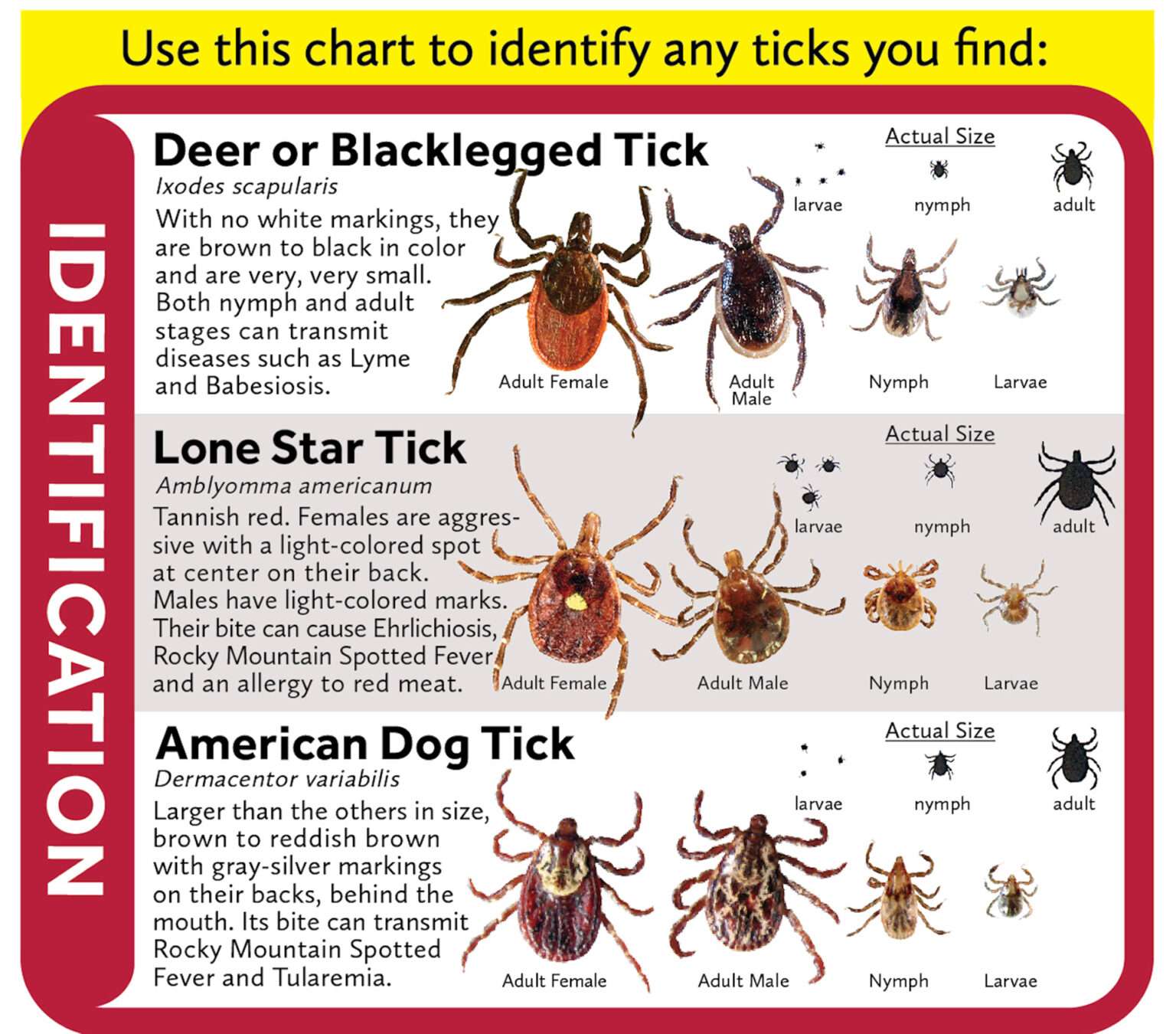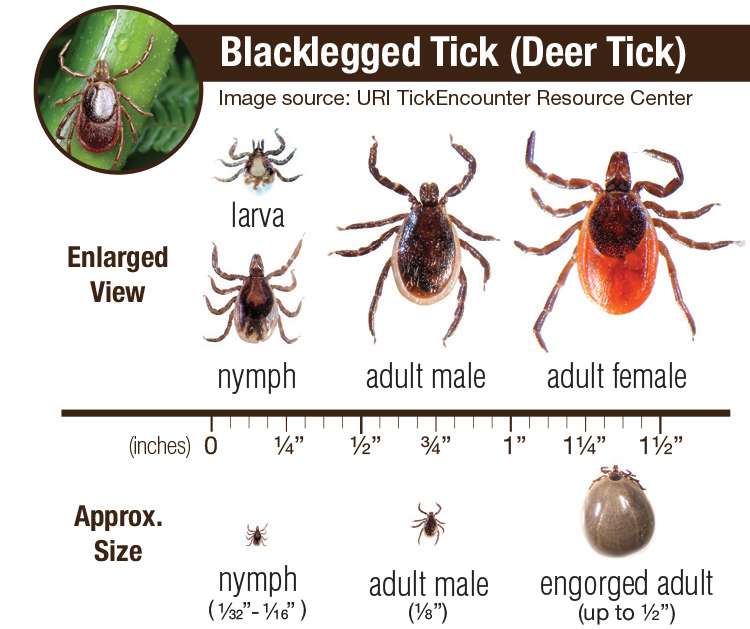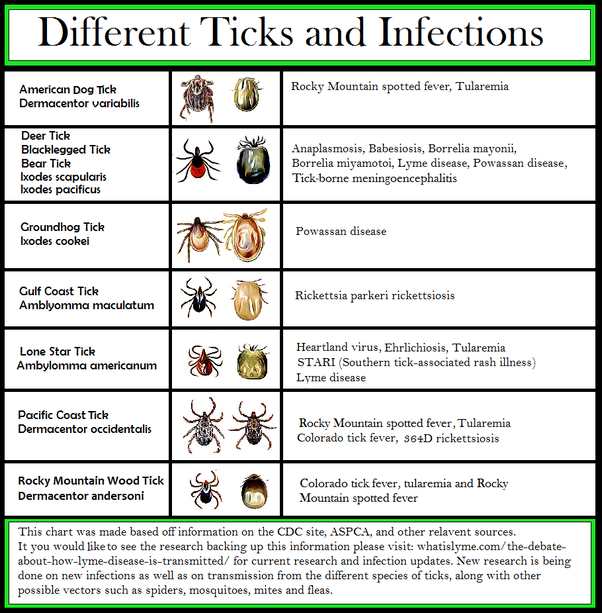What Season Do Ticks That Carry Lyme Disease Thrive
Are ticks out in winter?
Ticks that carry Lyme disease are active year-round and can survive in below-freezing temperatures, although their peak season of activity begins in April and runs through September. During this time, the hungry nymphal tick actively seeks a host, and its bite poses the greatest risk.
How Is Lyme Disease Transmitted
Ticks usually live in woods or tall grasslands in Canada, the United States, Europe, and Asia. Ticks can become infected with Borrelia burgdorferi by feeding on infected wild animals, and then can spread the bacteria when they feed on blood from the host. Ticks cannot fly – they hang onto small bushes or tall grasses and are usually found close to the ground. They wait for an animal or person to pass near them and when the animal or person makes contact, the ticks attach themselves to the skin to feed.
In North America, Lyme disease is transmitted mainly by two species of ticks:
- Blacklegged tick , Ixodes scapularis.
- Western blacklegged tick, Ixodes pacificus.
The Public Health Agency of Canada states that there no evidence that Lyme disease can spread from person-to-person. Pets, especially dogs, can get Lyme disease, but there is no evidence that pets can spread the infection directly to humans. They may, however, carry infected ticks into the home or yard which may increase the chance of transmission.
Whats The Best Way To Prevent A Tick Bite
Ticks cant fly or jump. But they live in shrubs and bushes and can grab onto you when you pass by. To avoid getting bitten:
- Wear pants and socks in areas with lots of trees and when you touch fallen leaves.
- Wear a tick repellent on your skin and clothing that has DEET, lemon oil, or eucalyptus.
- For even more protection, use the chemical permethrin on clothing and camping gear.
- Shower within 2 hours after coming inside. Look for ticks on your skin, and wash ticks out of your hair.
- Put your clothing and any exposed gear into a hot dryer to kill whatever pests might be on them.
How do you know if youve been bitten?
Since ticks are so small, youve got to have pretty good eyes to see them.
If you have a small, red bump on your skin that looks like a mosquito bite, it could be a tick bite. If it goes away in a few days, itâs not a problem. Remember, a tick bite doesnât necessarily mean you have Lyme disease.
If you notice a rash in the shape of a bulls-eye, you might have a tick bite. Talk to your doctor about treatment.
If you have an allergic reaction to ticks, youll notice a bite right away.
Recommended Reading: Over The Counter Treatment For Lyme Disease
Don’t Miss: Cowden Protocol For Lyme Disease
Types Of Ticks And Which Are High Risk For Lyme Disease
by Lyme Mexico | Jul 7, 2022 | News |
Its ideal to be aware of the different types of ticks out there. Read further on for all the important details.
Ticks can be found around the world. They are categorized into two different families. Hard ticks have 700 species, and soft ticks have 200 species. A total of 900 species of ticks is frightening. Fortunately, only a few will bite and pass on diseases to humans.
Ticks have eight legs, placing them in the same group as spiders. Yes, ticks are arachnids. The main difference between spiders and ticks is that ticks feed only on blood from mammals, including wildlife, pets, rodents, birds, and humans.
Can Wood Ticks Carry Diseases

Diseases Transmitted by the Rocky Mountain Wood Tick: Rocky Mountain Spotted Fever, Colorado Tick Fever, and Tularemia. The saliva from these ticks contains a neurotoxin that can sometimes cause tick paralysis in both humans and pets however, the paralysis usually dissipates within 24 to 72 hours after tick removal.
You May Like: The Cowden Protocol For Lyme Disease
Do Black Legged Ticks Carry Lyme Disease
Asked by: Otho Hermiston
In the United States, Lyme disease is caused by the bacteria Borrelia burgdorferi and Borrelia mayonii, carried primarily by black-legged or deer ticks. Young brown ticks often are no bigger than a poppy seed, which can make them nearly impossible to spot. To contract Lyme disease, an infected deer tick must bite you.
Protect Yourself From Ticks
Revised by Elmer Gray, Extension EntomologistPrevious versions of this manuscript were written by Burton Evans and Beverly Sparks, Former Extension Entomologists
Ticks are one of the most important groups of arthropods in Georgia because of their disease-transmitting capabilities. In Georgia, ticks are known to transmit several diseases, with Rocky Mountain Spotted Fever and Lyme disease being the most common. Tularemia is a long-recognized disease also transmitted by ticks, as are the more recently recognized diseases anaplasmosis, human ehrlichiosis , Southern tick-associated rash illness , and the recently found Heartland virus. Ticks also can cause infections if their mouthparts break off when they are removed from the skin and can leave persistent welts resulting from reactions to their saliva. If tick populations are high in recreation and camping areas, participation may drop off, causing monetary loss to the leisure industry. Costs to control ticks in yards and homes and on pets and people also can be significant.
Recommended Reading: Do You Ever Recover From Lyme Disease
Which Tick Is Most Likely To Carry Lyme Disease
Black-legged or deer ticks are commonly found in areas with Lyme disease infections and their bacteria Borrelia burgdorferi and Borrelia mayonii. Often, young brown ticks are just a grain of poppyseed, so detecting them can be incredibly difficult. The likelihood of contracting tickborne diseases depends upon biting an infected deer tick.
What Do You Do If An American Dog Tick Bites You
Immediately wash any clothes worn outside. If you have a bite from an American dog tick, use fine-tipped tweezers to grasp it as close to the skins surface as possible. Pull upward with steady, even pressure. Dont twist or jerk the tick as this can cause the mouthparts to break off and remain in the skin.
Dont Miss: Pictures Of Ticks That Cause Lyme Disease
Read Also: Pictures Of Lyme Disease Carrying Ticks
What Is Disseminated Lyme Disease
- This is when the bacteria that causes Lyme disease spreads throughout your body.
- This can occur within days to months after the tick bite.
- Symptoms include:
- Multiple erythema migrans rashes.,
- Nervous system involvement .,
- Heart involvement .,
- Connective tissue involvement .,
- Eye involvement .,
Where Does Lyme Disease Occur In Ohio
Blacklegged ticks that carry Lyme disease are most commonly found in the eastern and southern areas of the state, but are likely to occur in suitable wooded habitat throughout most or all of Ohio. On the map below, each dot represents one case of Lyme disease and is placed randomly in the patients county of residence. The presence of a dot does not necessarily mean that the Lyme disease infection was acquired in Ohio. The place of residence can be different from the place where the patient became infected.
Don’t Miss: How Can I Get Tested For Lyme Disease
Use Insect Repellents No Matter What Ticks Carry Lyme Disease
Sometimes, wearing the right clothes and checking for ticks often just dont cut it. One more way to prevent ticks from sticking to you is using repellents. For this, you have two options: you can use DEET products or products with permethrin. The former is more gentle preventing ticks from latching without killing them. However, they are not guaranteed to work 100% of the time. Products with permethrin kill ticks but are pretty harsh on the user. The latter, on the other hand, is more aggressive. If you opt for this solution, avoid spraying directly on your skin.
Ticks That Are High Risk For Lyme Disease

1. The Deer Tick
The Eastern and Western black-legged ticks are known commonly as deer ticks. Eastern black-legged ticks have a scientific name of Ixodes Scapularis and exist in the mid-west and eastern parts of America. Ixodes Pacificus refers to the Western black-legged tick found throughout the western states.
Deer ticks are the only ticks known to carry Lyme disease. They also carry many other bacteria that can cause co-infections when transmitted into your bloodstream. Not only will you be infected with Lyme, but you could also have Babesiosis, Borrelia mayonii, anaplasmosis, ehrlichiosis, Powassan disease, and others.
2. The American Dog Tick
Female American dog ticks are the ones that will bite you and transmit disease specifically Rocky Mounted Spotted Fever. Other possible transmissions from a dog tick include Tularemia, Ehrlichia, anaplasmosis, and tick paralysis.
3. The Brown Dog Tick
The brown dog tick is reddish-brown, unlike the American dog tick, which is dark brown. The brown dog tick transmits diseases to humans that include Rocky Mounted Spotted Fever, Q Fever, and rickettsia. Dogs are especially at risk since this tick can transmit specific diseases only dogs can get.
4. The Groundhog Tick
The groundhog tick, or woodchuck tick, is a light brown or blond arachnid. It is found mainly in the Eastern states and transmits the Powassan virus to humans and animals.
5. The Lonestar Tick
6. The Pacific Coast Tick
7. Rocky Mountain Wood Tick
Also Check: Should I Be Tested For Lyme Disease
Concluding Thoughts On Surveillance Spectrum And Burden Of Tick
Gordon Schutze, M.D., Baylor College of Medicine
Creating a repository for specimens of blood and cerebrospinal fluid from patients with tick-borne diseases can improve the accuracy of diagnostic tests and disease diagnosis. Such a repository needs to include demographic information on patients and information on their diagnosis, treatment, and outcome. A well-funded network of researchers investigating tick-borne diseases could maintain such a repository, which also would enable them to advance knowledge of these diseases.
Clinicians clearly need new methods for diagnosing tick-borne diseases, given the genetic diversity among different strains of a pathogen and the realization that new species may be responsible for a larger burden of disease than previously recognized . Clinicians also need better tests to accurately differentiate between patients with acute tick-borne illness and those previously infected with tick-borne disease.
Blacklegged Tick Also Known As The Deer Tick
Image source: /content/dam/soi/en/web/idph/files/deertick.jpg
All three active stages of the blacklegged / deer tick will feed on a variety of hosts including people. After the eggs hatch in the spring, the very tiny larvae feed primarily on white-footed mice or other small mammals. The following spring, the larvae molt into pinhead-sized, brown nymphs that will feed on mice, larger warm-blooded animals and people. In the fall, they molt into adults that feed primarily on deer, with the females laying eggs the following spring. Adults are reddish-brown and about 1/8-inch long .
These ticks are found in wooded areas along trails. The larvae and nymphs are active in the spring and early summer adults may be active in both the spring and fall. The blacklegged / deer tick can transmit Lyme disease, babesiosis and possibly ehrlichiosis to humans.
The deer tick has been found sporadically in many Illinois counties. However, in recent years it has been common only in limited areas, mostly in northern Illinois . Additionally, Illinois residents may encounter the deer tick during trips to Michigan, Minnesota, Wisconsin or the northeastern United States where it is very common in some areas.
Read Also: How Soon Do Lyme Disease Symptoms Appear
Lyme Disease Tick Size
The Lyme disease bacterium, Borrelia burgdorferi, is spread through the bite of infected ticks.The blacklegged tick spreads the disease in the northeastern, mid-Atlantic, and north-central United States.The western blacklegged tick spreads the disease on the Pacific Coast.Ticks can attach to any part of the human.
Rocky Mountain Spotted Fever
The Tick
- RMSF is transmitted to humans by the bite of an infected American dog tick.
- The infected tick must be attached to a human for only about four hours to transmit the bacteria.
Symptoms:
- RMSF is characterized by a sudden onset of moderate to high fever , severe headache, fatigue, deep muscle pain, chills and rash.
- The rash begins on the legs or arms, may include the soles of the feet or palms of the hands and may spread rapidly to the trunk or rest of the body.
Treatment
- Certain antibiotics such as tetracycline or chloramphenicol may be effective in treating the disease.
- RMSF can be fatal, so if you are concerned about symptoms, contact your doctor immediately.
Read Also: Samento And Banderol For Lyme Disease
What States Have The Most Ticks
A recent report from the Centers for Disease Control and Prevention found that there were more than 640,000 tick and vector-borne disease cases in the United States between 2004 and 2016. In that time, disease cases from tick, mosquito, and flea bites tripled in the United States. The state with the most cases is Pennsylvania.
Who Is At Risk
Many occupations may be at risk, including forestry, farming, veterinarians, construction, landscaping, ground keepers, park or wildlife management, and anyone who either works outside or has contact with animals that may carry ticks
Similarly, any person who spends a lot time outdoors , especially in grassy or wooded areas may also be at risk.
Read Also: What Is Chronic Lyme Disease In Humans
How Is Lyme Disease Spread
People can become infected if they are bitten by a black-legged tick that is carrying Borrelia burgdorferi these ticks usually need to remain attached to a person for at least 36 hours to transmit the bacteria. These ticks live in forested or brushy areas and perch on tips of grasses or shrubs, then climb onto people or animals that brush by. They then crawl until they find a suitable place to bite. Ticks can bite any skin on the human body, but are often found in hard-to-see areas, such as the groin, armpits, or scalp.
Black-legged ticks pick up the bacteria after feeding on infected rodents. On the Pacific Coast, the western black-legged tick spreads Lyme disease. Both the western black-legged tick and the black-legged tick responsible for spreading Lyme disease in the northeastern, mid-Atlantic, and north-central United States , are also called deer ticks.
There is no evidence that Lyme disease can be passed from one person to another through touching, kissing, or sex. While dogs and cats can also get Lyme disease, there is no evidence that they can spread the disease directly to their owners. However, pets can transport infected ticks that then attach onto humans.
Lyme Disease Signs And Symptoms

Most symptoms of Lyme disease in humans usually appear between three and 30 days after a bite from an infected blacklegged tick.
You should contact your local public health unit or speak to a health care professional right away if you have been somewhere that ticks might live and experience any of the following symptoms:
- a bulls-eye rash (a red patch on the skin that is usually round or oval and more than 5 cm that spreads outwards and is getting bigger
- a bruise-like rash
- spasms, numbness or tingling
- facial paralysis
If not treated, Lyme disease can make you feel tired and weak and, if it gets really bad, it can even harm your heart, nerves, liver and joints. Symptoms from untreated Lyme disease can last years and include recurring arthritis and neurological problems, numbness, paralysis and, in very rare cases, death.
Don’t Miss: Food Delivery East Lyme Ct
When To Contact A Physician After A Tick Bite
If you experience a rash that looks like a bull’s-eye, or a rash anywhere on the body or an unexplained illness accompanied by fever following a tick bite, you should consult your physician and explain that you were bitten by a tick. Disease carried by ticks can be treated with antibiotics. However, the type of antibiotic can vary and individuals should be treated early in the infection.
Fact sheets about symptoms and treatment of tickborne diseases may be obtained from local health departments, by calling the Departments central office at 217-782-2016 or from the Departments Web site at www.dph.illinois.gov.
Which Ticks Carry And Transmit Lyme Disease
Not all bugs are what youd call dangerous. Flies are usually little more than a nuisance. And while the occasional ant bite is frustrating, its rare to have a severe allergic reaction.
Some bugs, though, need to be avoided. Ticks are one such example. Aside from the fact that they have the repulsive habit of attaching themselves to you and sucking your blood, ticks are capable of spreading a wide range of diseases.
One disease commonly associated with ticks is Lyme disease. However, not all ticks are capable of carrying and spreading Lyme disease. In fact, only a handful of tick species transmit disease.
Are you wondering which species of tick are capable of infecting you with Lyme disease? Keep reading to find out.
Don’t Miss: How To Get Rid Of Chronic Lyme Disease
The Chance Of Getting Lyme Disease
Not all ticks in England carry the bacteria that causes Lyme disease.
But its still important to be aware of ticks and to safely remove them as soon as possible, just in case.
Ticks that may cause Lyme disease are found all over the UK, but high-risk places include grassy and wooded areas in southern and northern England and the Scottish Highlands.
Ticks are tiny spider-like creatures that live in woods, areas with long grass, and sometimes in urban parks and gardens. Theyre found all over the UK.
Ticks do not jump or fly. They attach to the skin of animals or humans that brush past them.
Once a tick bites into the skin, it feeds on blood for a few days before dropping off.
Also Check: Do You Get A Rash With Lyme Disease